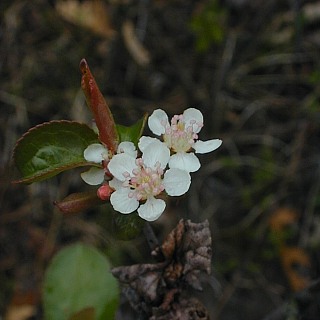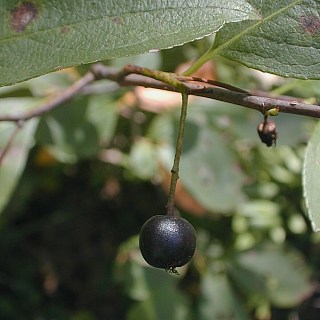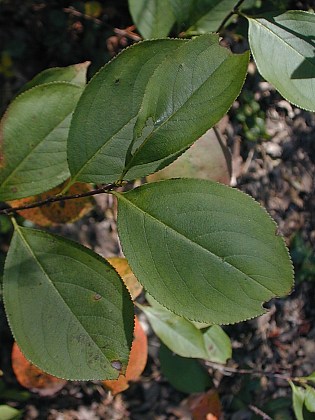Description: This small shrub is 3-8' tall; it branches readily and becomes bushy in appearance. The woody stems are brown to grey and become more rough or winkled with age. The alternate leaves are up to 4" long and 2½" across; they are oval-ovate or obovate in shape, finely serrate or finely crenate along the margins, and hairless. The leaves are often broadest beyond the midpoint and they have short obtuse tips. The lower surface of each leaf is a lighter shade of green than the upper surface. The upper midvein of each leaf has tiny black glands that are best observed with a hand lens. At the base of each leaf, there is a slender petiole. The flowers develop from the upper and outer branches in compound cymes; each compound cyme has about 12 flowers, although their abundance varies.

Each flower is about ½" across, consisting of 5
white rounded petals, a reddish green calyx with 5 short teeth, and
about 16 stamens surrounding the styles in the center. The conspicuous
anthers of the stamens are pink. While each flower is rather small,
they are produced in abundance. The blooming period occurs during the
late spring and lasts about 3 weeks. During late summer, each
fertilized flower is replaced by a black leathery fruit containing
several small seeds. This fruit is globoid and about 1/3" (8 mm.)
across. The
mature fruits of Black Chokeberry are deciduous and fall to the ground
within a short period of time. The deciduous leaves become bright
yellow, orange, or red during the fall. The root system consists of a
woody branching taproot. This species occasionally forms large
colonies, but this is uncommon.
Cultivation:
The preference is light shade to full sun, moist to dry-mesic
conditions, and
a sandy acid soil. Some populations of this shrub occur in areas with
considerable moisture, while other populations can be found at
surprisingly dry sites. This can affect the adaptability of individual
plants.

Range &
Habitat:
The native Black Chokeberry is occasional in sandy areas of NE
Illinois, otherwise
it is rare or absent within the state (see Distribution
Map). Habitats include sand prairies, sandy shrub prairies,
hill prairies, thickets, sandy savannas, sandy areas along woodland
paths, sandstone glades, rocky bluffs, moist sandy thickets, and bogs.
In southern Illinois,
where it is rare, this shrub is restricted to glades and rocky upland
woods. In wooded areas, occasional wildfires are probably beneficial in
maintaining the habitat of this species as this reduces competition
from taller canopy trees (e.g., Black Oaks). Black Chokeberry is one of
the shrubs that invades mesic sand prairies, sometimes forming its own
'shrub prairie.'
Faunal Associations:
The nectar and pollen of the flowers undoubtedly attract bees and other
insects. Among the bees, Osmia spp. (mason Bees)
and Andrena spp. (Andrenid Bees) are common
visitors of spring-blooming shrubs in the Rose family. The caterpillars
of the butterfly Satyrium titus (Coral Hairstreak),
the moth Catocala praeclara (Praeclara Underwing),
and the moth Lomographa semiclarata (Bluish Spring
Moth) feed on the foliage of Photinia spp.
(Chokeberries). Some birds use Chokeberries as a food source, including
the Ruffed Grouse (buds, fruit) and Cedar Waxwing (fruit). Because the
mature fruit of Black Chokeberry is black and soon falls to the ground,
it is especially likely to be eaten by various mammals, including the
Black Bear, Red Fox, and Fox Squirrel. These birds and mammals help to
disperse the small seeds in the fruit. Both the Cottontail Rabbit and
White-Tailed Deer browse on the twigs and foliage to a limited extent.

Photographic
Location:
The photographed shrubs were growing along nature trails in a sandy
savanna and a sandy thicket in Kankakee County, Illinois.
Comments:
Black Chokeberry (Photinia
melanocarpa) is one of the spring-flowering shrubs of the
Rose
family that most people are unfamiliar with. It remains quite small in
size and lacks thorns. Another native species, Red Chokeberry (Photinia
arbutifolia), has pubescent leaves and red
fruits. Sometimes these two species hybridize to produce Purple
Chokeberry (Photinia × prunifolia), which has purple
fruit and
other characteristics that are intermediate between its two parents.
Some authors, however, regard Purple Chokeberry as a distinct species.
Chokeberries (Photinia
spp.) are somewhat similar to crabapples (Malus
spp.),
except that the latter produce larger flowers (1-2"
across) in simple cymes. Both chokeberries and crabapples produce
fruits containing several small seeds. Many shrubs and small trees of
the Rose family produce fruits containing a single stone (a large seed
with a hard covering). This includes various cherries and plums (Prunus
spp.). A scientific synonym of Black Chokeberry is Aronia melanocarpa.